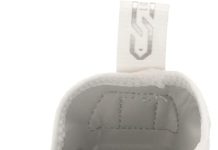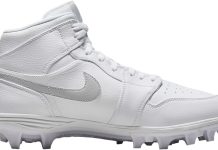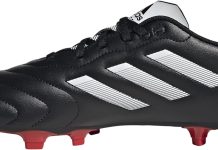In baseball, the debate between plastic and metal spikes for pitching mounds has long been a discussion among players and coaches alike. Each type has advantages and disadvantages, but the ultimate question remains: which is better?
In this article, we will explore the pros and cons of both plastic and metal spikes, shedding light on the crucial factors that can significantly impact a pitcher’s performance on the mound.
So, whether you’re a seasoned player looking to switch up your gear or a curious enthusiast delving into the nuances of baseball equipment, join us as we unravel the mystery behind the ultimate choice for pitching: plastic or metal spikes.
1. Durability
Review contents
1.1. Metal Spikes
Regarding durability, metal spikes have proven to be highly resilient. These spikes are typically constructed using high-quality materials such as steel or aluminum, known for their strength and longevity. Metal spikes are designed to withstand the rigorous demands of pitching, ensuring they won’t wear down or break easily. This durability translates into a longer lifespan, making them a reliable choice for athletes looking for spikes that can withstand frequent use.
1.2. Plastic Spikes
While plastic spikes may not have the same reputation for durability as their metal counterparts, advancements in technology have led to the development of more robust and long-lasting plastic materials. Modern plastic spikes are often manufactured using reinforced polymers or composite materials that enhance their strength and resilience. These spikes are designed to endure the rigors of pitching, providing adequate durability for most athletes. However, it is essential to note that plastic spikes may not offer the same level of durability as metal spikes in extreme conditions or for athletes with particularly aggressive pitching styles.
2. Traction
2.1. Metal Spikes
Metal spikes are renowned for their exceptional traction on various surfaces, including pitching mounds. Due to their sharp and rigid nature, metal spikes dig deep into the ground, providing a secure grip and preventing slippage during the pitching motion. This enhanced traction allows pitchers to maintain stability and control throughout their throwing motion, reducing the risk of injury and optimizing performance. Metal spikes are especially beneficial in wet or muddy conditions, where maintaining traction is crucial.
2.2. Plastic Spikes
Although not as sharp or rigid as metal spikes, plastic spikes offer adequate traction for most pitching needs. The design of plastic spikes often incorporates a pattern of small protrusions or studs that help grab the surface and provide traction. While they may not penetrate the ground as deeply as metal spikes, these studs offer sufficient grip for most pitching mounds. Plastic spikes are handy for pitching on synthetic turf or indoor facilities where metal spikes may not be allowed due to surface restrictions.
3. Stability
3.1. Metal Spikes
When it comes to stability, metal spikes excel. The rigid structure of metal spikes provides a solid and stable platform for pitchers, ensuring their feet remain firmly planted during pitching. This stability plays a vital role in maintaining balance and control, allowing pitchers to confidently deliver accurate throws. Metal spikes are advantageous for pitchers who generate significant power and require a firm foundation to transfer their energy efficiently.
3.2. Plastic Spikes
Although not as rigid as metal spikes, plastic spikes still provide a respectable level of stability. The flexibility of plastic materials allows for a certain degree of natural movement, which can be beneficial for pitchers seeking a more dynamic and responsive feel. While plastic spikes may not offer the same level of stability as their metal counterparts, they can still provide sufficient support and balance for most pitchers, especially those with a more finesse-based approach.
4. Maintenance
4.1. Metal Spikes
Metal spikes are relatively low-maintenance, requiring minimal attention to keep them in optimal condition. Generally, metal spikes can be easily cleaned by removing dirt or debris using a brush or cloth. To prevent rusting, it is essential to ensure that any moisture is thoroughly wiped away after use. Additionally, periodically checking the spikes for wear or damage is recommended, as replacing worn spikes can help maintain their performance and prevent potential injury.
4.2. Plastic Spikes
Plastic spikes are also relatively easy to maintain. Like metal spikes, cleaning plastic spikes involves removing dirt or debris using a brush or cloth. Due to the material’s resistance to corrosion, plastic spikes do not require as much attention after use. However, it is still important to regularly inspect and replace any worn or damaged spikes to ensure consistent performance and prevent any potential issues on the pitching mound.
5. Comfort
5.1. Metal Spikes
Regarding comfort, metal spikes may not be the top choice for some pitchers. The rigid nature of metal spikes can sometimes cause discomfort or pressure points on the feet, especially during extended periods of use. However, many athletes find that metal spikes offer stability and support, compensating for any initial discomfort and gradually becoming more comfortable.
5.2. Plastic Spikes
Plastic spikes often provide a higher level of comfort compared to metal spikes. Plastic materials’ flexibility and lighter weight make them more forgiving on the feet, reducing discomfort during prolonged pitching sessions. Plastic spikes also often incorporate cushioning or padding elements, further enhancing comfort levels for pitchers. Plastic spikes can be an excellent choice for athletes who prioritize comfort and want to minimize any potential foot fatigue.
6. Price
6.1. Metal Spikes
Metal spikes generally tend to be more expensive than plastic spikes. The premium materials and manufacturing processes producing metal spikes contribute to their higher price range. However, metal spikes can offer long-term value for athletes who prioritize durability and performance, as their lifespan often exceeds that of plastic spikes. Investing in metal spikes may require a more significant upfront investment, but their longevity can result in cost savings in the long run.
6.2. Plastic Spikes
Plastic spikes are typically more affordable compared to metal spikes. The cost of manufacturing plastic spikes is generally lower, leading to a more budget-friendly price point for athletes. While plastic spikes may not offer the same level of durability or performance as metal spikes, they can still provide a sufficient option for pitchers on a tighter budget or those prioritizing cost-effectiveness.
7. Customization
7.1. Metal Spikes
Metal spikes often offer a higher degree of customization compared to plastic spikes. With metal spikes, athletes can choose from various designs, colors, and styles to suit their personal preferences. Some manufacturers even offer customization options, allowing pitchers to add their names, numbers, or team logos to their spikes. The ability to personalize metal spikes enables athletes to showcase their individuality and create a unique look on the pitching mound.
7.2. Plastic Spikes
While plastic spikes may not offer as many customization options as metal spikes, some choices are still available for athletes. Plastic spikes usually come in various colors and styles, allowing pitchers to select a design that matches their preferences or team uniform. Although the level of customization may not be as extensive as with metal spikes, plastic spikes still allow athletes to express their style on the pitching mound.
8. Weight
8.1. Metal Spikes
Metal spikes tend to be heavier compared to plastic spikes. The sturdy construction and materials used in metal spikes contribute to their higher weight. While the added weight may not be a significant concern for some athletes, it can affect others, particularly those who prioritize agility or have a more finesse-based pitching style. Pitchers who rely on quick movements and swift footwork may find the heavier nature of metal spikes to be slightly restrictive.
8.2. Plastic Spikes
Plastic spikes are generally lighter than their metal counterparts. The lightweight nature of plastic materials allows for greater agility and ease of movement. Athletes who prioritize speed and quickness on the pitching mound may prefer the lighter feel of plastic spikes, as they enable more effortless footwork and maneuverability. The reduced weight of plastic spikes can also contribute to a lower risk of foot fatigue during extended pitching sessions.
9. Environmental Impact
9.1. Metal Spikes
Metal spikes may have a higher environmental impact compared to plastic spikes. The manufacturing processes involved in producing metal spikes, as well as the extraction of raw materials, can contribute to increased energy consumption and greenhouse gas emissions. Additionally, if not correctly disposed of, metal spikes can end up in landfills, potentially adding to environmental pollution. However, metal spikes are often highly durable and long-lasting, so they may not need to be replaced as frequently as plastic spikes, reducing overall waste.
9.2. Plastic Spikes
Plastic spikes, particularly those made from recycled or eco-friendly materials, can have a lower environmental impact than metal spikes. The production of plastic spikes typically requires less energy and emits fewer greenhouse gases than the production of metal spikes.
Additionally, the recycling potential of plastic spikes is higher, allowing for reduced waste and potential reuse of materials. However, the durability and lifespan of plastic spikes may be shorter, resulting in higher replacement frequency and potential waste generation.
10. Regulations
10.1. Metal Spikes
Regarding regulations, metal spikes may have certain restrictions depending on the sport or league. Some leagues or facilities impose restrictions on metal spikes due to concerns regarding damage to playing surfaces. Pitchers need to familiarize themselves with their sport or league’s specific rules and regulations to ensure compliance and avoid unnecessary penalties or disqualifications.
10.2. Plastic Spikes
Plastic spikes are generally more widely accepted and allowed in various sports and leagues. Due to their lighter and less disruptive nature, plastic spikes are often considered a safer and more suitable option for certain playing surfaces. Pitchers using plastic spikes are less likely to encounter restrictions or limitations when it comes to adhering to the regulations of their sport or league.
In conclusion, the choice between metal and plastic spikes for pitching mounds ultimately depends on individual preferences and priorities. Metal spikes offer excellent durability, traction, stability, and customization options, but they may come at a higher price and have potential restrictions in certain leagues.
On the other hand, plastic spikes provide sufficient durability and traction, along with a more comfortable and affordable option. Additionally, plastic tips can offer a lighter weight and lower environmental impact but may have limitations in customization. Consider your specific needs and regulations to make an informed decision that enhances your pitching performance.





































